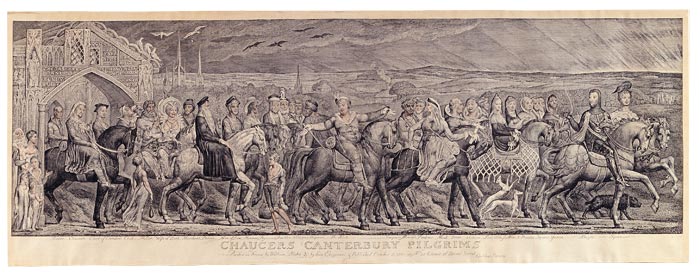
This is a magnificent example of Blake's largest print, one of only three known impressions to which he added watercolor. The engraving is known in five states, and the present sheet is the only hand-colored example of the third state of the image. Blake's use of line engraving, emulating the styles of early printmakers Albrecht Dürer and Lucas van Leyden, evokes the character of Chaucer's poetry.
Blake painted the pilgrims after a quarrel with R. H. Cromek and Thomas Stothard regarding whether the commission had originally been Blake's. The painting was exhibited at his brother's Soho shop in 1809, and this engraving was created from it.
I. Engravings
William Blake was tutored by his mother, given drawing lessons at the age of ten, and at fifteen apprenticed to James Basire, one of the most prominent engravers of the day. Seven years later, when the apprenticeship was complete, Blake was admitted to study at the Royal Academy. Because of this solid instruction, he was admired for his craftsmanship and often identified as "Mr. Blake, the engraver." Throughout his life, he maintained that engraving was a true art form: "Painting is Drawing on Canvas & Engraving is drawing on Copper & Nothing Else." Blake's prints demonstrate his strong commitment to line, developed through Basire and enhanced by his own creativity. Fortunately his engraver's training would support him, though not well, for the remainder of his life. At forty-six, he wrote, "I curse & bless Engraving alternately because it takes so much time & is so untractable, tho capable of such beauty & perfection."
